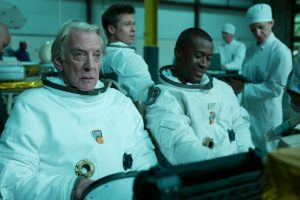By Chic DiCiccio
“Ad Astra” is an understated, quiet and thought-provoking $100 million space epic. It moves at a steady, if not slow pace, but is packed with beautiful imagery, heart and humanity. With all that being said, it’s a virtual certainty to fail at the box office.

Photo courtesy of New Regency Pictures
Just like his last film, “The Lost City of Z,” director/writer James Gray has done epic filmmaking with such skill and intelligence that he’s essentially priced himself out of the market. “Ad Astra” is being sold as a science fiction adventure when it’s everything but and could leave the general public wanting more despite Brad Pitt’s star power.
“Ad Astra” is basically “Apocalypse Now” in space. Pitt is Major Roy McBride, a successful astronaut that cannot get out of his more famous father’s shadow. Roy’s old man, Captain Clifford McBride (Tommy Lee Jones), piloted the first ship to reach Saturn, Jupiter, and his thought to be final destination, Neptune. At some point in Clifford’s journey, Earth lost contact with him and his crew, which led them to presume they were deceased.
It turns out that Good Old Dad may or may not be responsible for a series of galaxy-threatening power surges emanating from Neptune. The U.S. Armed Forces orders Roy to Mars in an effort to convince his dad to ask for help or come back to Earth.
Roy’s inner monologue (a truly great narration by Pitt) keys us in on his feelings towards his father, his mission and, well, life in general. There are hints of a failed marriage (Liv Tyler, sparsely seen and criminally underused) and even his superiors (played by David Ortiz, Donald Sutherland, among others) seem to respect his austere lifestyle.
If Terrence Malick made an introspective movie about father and son relationships that happened to take place in outer space, it would be “Ad Astra.” The main difference is that this movie moves at a very crisp pace. Gray and his cinematographer, Hoyte van Hoytema, linger on gorgeous shots of planets and the stars, but everyone seems to last the perfect amount of time.
There’s no doubt that “Ad Astra” isn’t going to please everyone, particularly those that are sold on this movie being some kind of sci-fi adventure. This movie is also more about themes than story, which could only further that disappointment. It is also an unbelievably quiet movie with purposeful and effective beats between spoken words that create more tension than any action movie could ever dream.
Pitt has often been accused of stiffness or having limited range, but that couldn’t be further from the truth. Pitt is solemn, stoic and calm in “Ad Astra,” but somehow conveys agonizing levels of pain and anger without outwardly showing it. His eyes tell more of his story than his words, and whatever praise Pitt receives for this movie, it’s well deserved.
“Ad Astra” is thought provoking, visually spectacular and, at around $10, much cheaper than a visit to the shrink. Who would have thought that the only thing more vast than space exploration was the journey to self-discovery?
